You’re at home, you decide you want a coffee, and you need it quick cause you’re about to run out the door. What do you make? I can tell you right now it’s not espresso.
I timed myself to make coffee on some of our equipment at the BH office with a goal to work out the speed, energy demand, and cost effectiveness of each method: Two espresso machines, two kinds of cezve, a freeze dried specialty instant and a spray dried commodity instant. Each method was standardised to a typical recipe: 8g of coffee for Turkish, 4g for the instants, and a 1g double shot (40mL yield) for espresso. (Note: it’s a slightly lower dose than you may be used to because the Mina has a 54mm basket).
The time trial commenced from the moment the coffee beans hit the grinder. And in each case, the equipment was not preheated. Each test started with a cold espresso machine — so view this discussion from the home barista’s perspective! We’ve got a nice Dalla Corte Mina in the office. It’s a compact home/light commercial one-group machine. It’s comparable in size and performance to that class of ultra one-group machines like the KVDW Speedster, the Slayer Single Group, the LM GS3, or the Synesso ES1. Think Lambo — but coffee. It took 15:30 minutes to make an espresso on the Mina because it took 14:15 for the machine to heat up. Fair dos, it needs to heat a 3L steam boiler and a 500mL brew boiler to get up to speed.
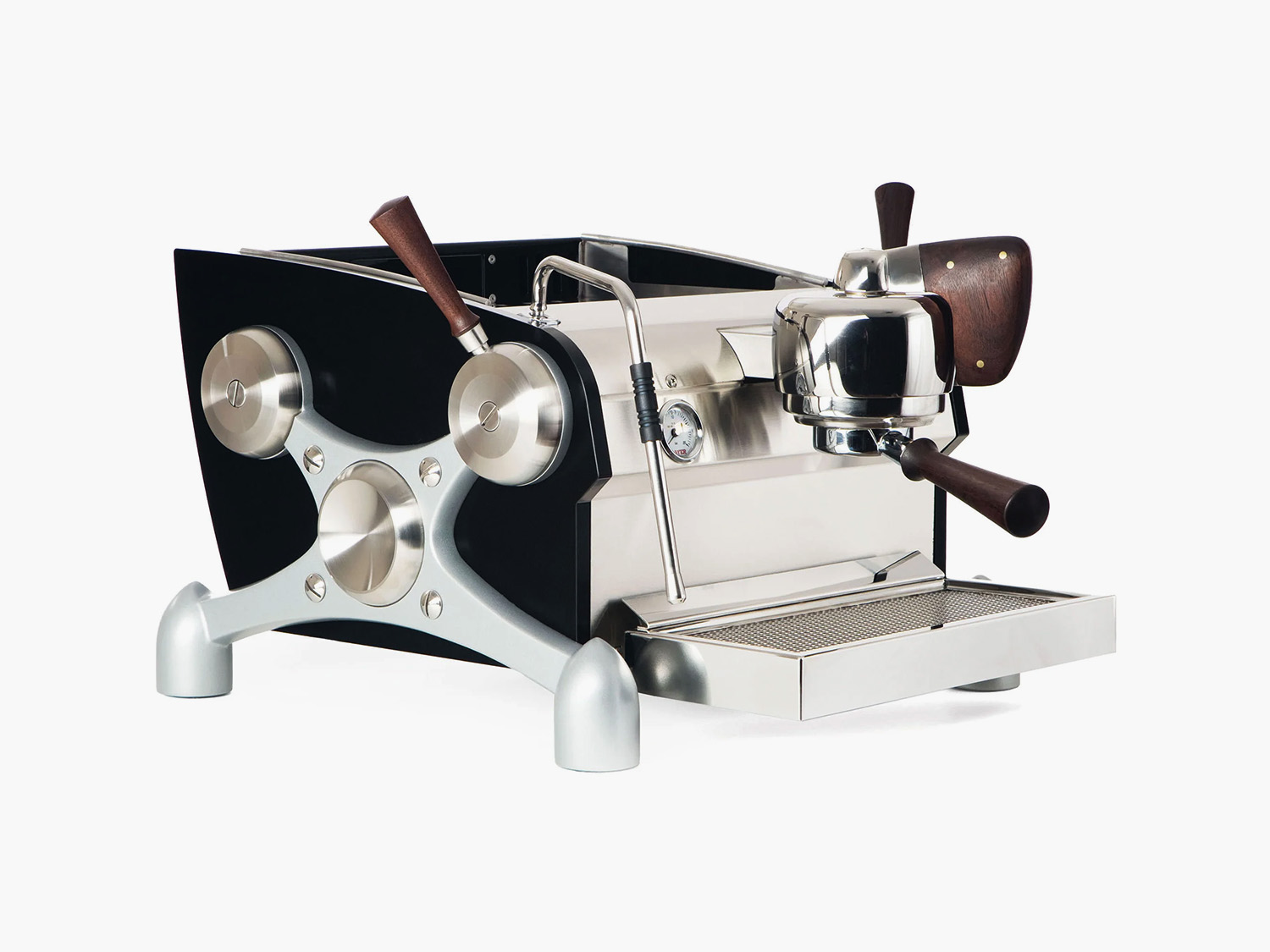
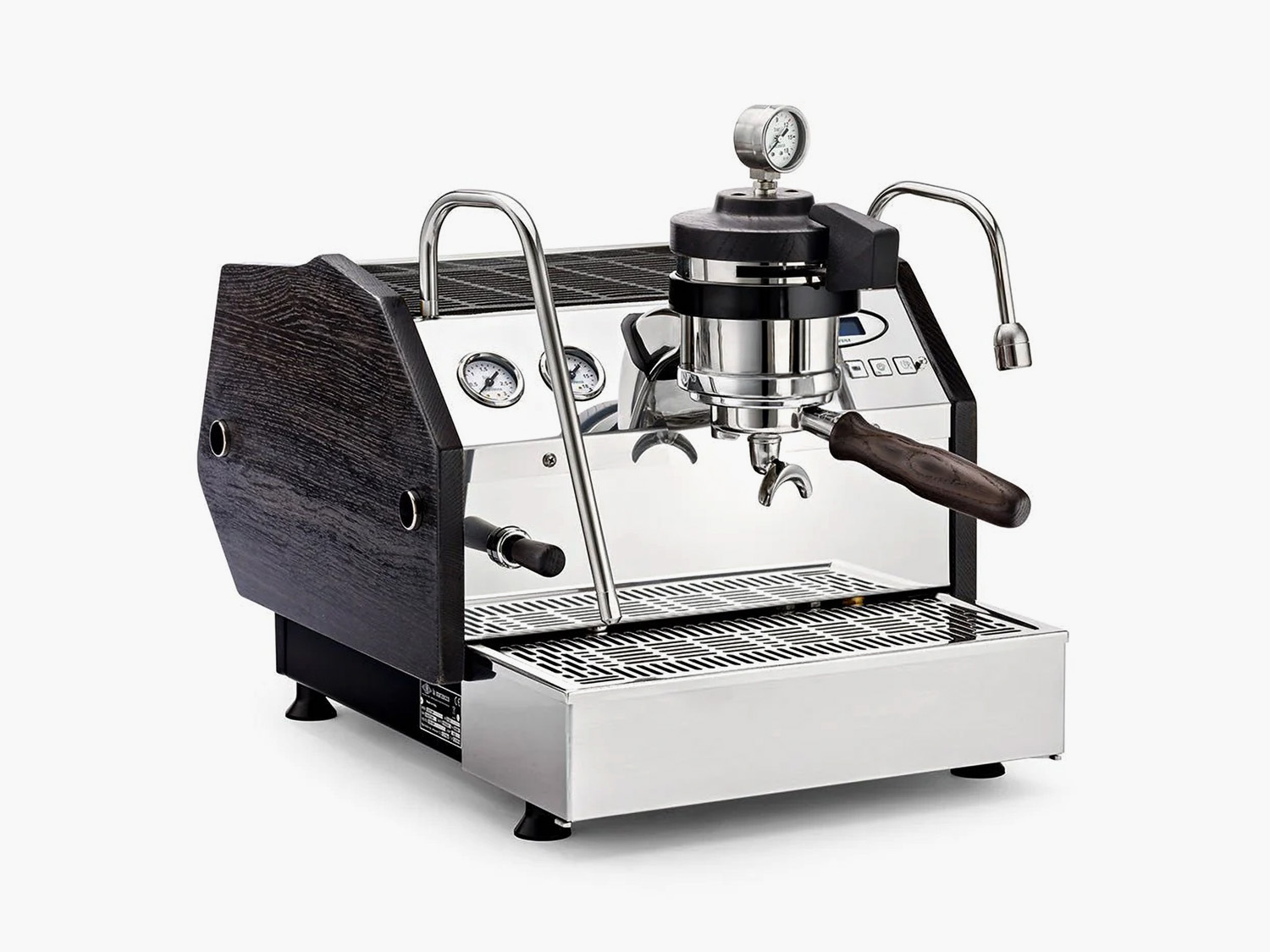 Ultra one group machines (from top left): Kees Van Der Westen Speedster, Synesso ES1, Slayer Espresso One Group and the La Marzocco GS3
Ultra one group machines (from top left): Kees Van Der Westen Speedster, Synesso ES1, Slayer Espresso One Group and the La Marzocco GS3Now what about if you tried this test on a prosumer machine like the Decent Espresso DE1? We’ve got a Decent Espresso machine in the office, too. Flow profiling capabilities aside, it’s a wiser choice if you’re in a serious hurry and you’re needing a quick cup. That puppy powers up and is ready to brew in 135 seconds. So, including preparation and extraction time, for us, that’s an espresso in three minutes and 25 seconds. Solid speed there, but still not the fastest performer in the time trial.
For the instant coffee test, we boiled precisely the amount of water we required to make a 200mL cup. This was generous of us for the instant because, if I observe any of the more senior members of my family, they invariably boil at least half a litre of water for a single cup. 200mL of water took a lightning one minute and five seconds to boil. Ten additional seconds to measure out the water after boiling and you have your instant coffee preparation in 75 seconds. A pretty clear winner on the speed side of things.
And finally, how about the mighty cezve? From grinding (which for cezve takes longer than normal due to the very fine grind) the brewed coffee was in the cup 2 minutes and 30 seconds later. That’s cold water up to 95°C in two and a half minutes including grind time. Our brew ratio was 8g to 100mL, and we used a silver lined copper cezve which is highly conductive. Copper is 25 times more conductive than stainless steel. That’s impressive timing compared to the espresso, but actually, we got that time down to under two minutes using a stainless steel cezve, brewed on the induction hob. Despite the loss in conductivity, the efficiency of the induction hob beat the copper cezve with a total time of 1:55.
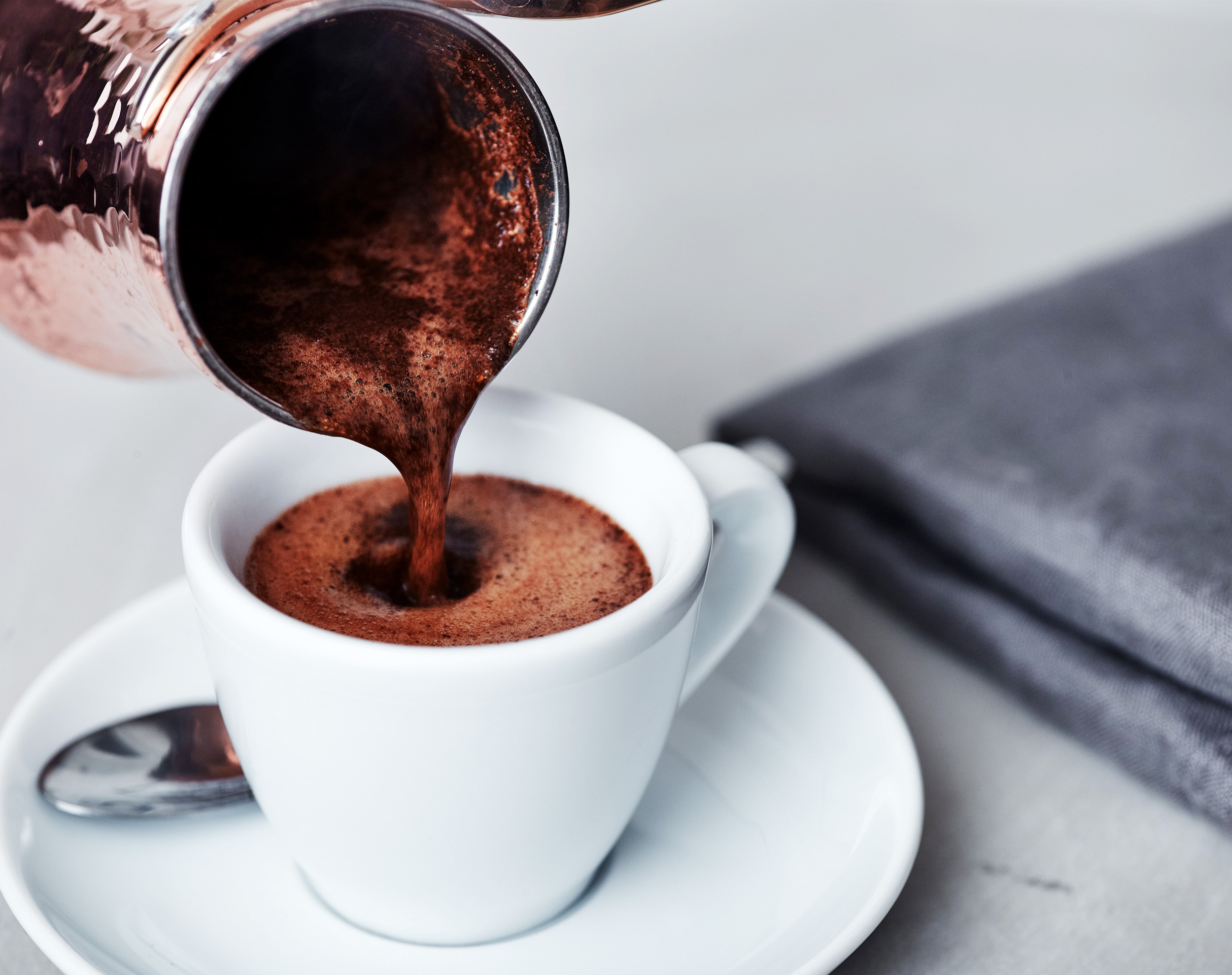 A copper cezve by Soy
A copper cezve by Soy
Results: Cezve vs Instant Coffee vs DC Mina vs DE1
For preparation time, unsurprising, the instants were the fastest at 75 seconds, but what is surprising is how close behind them the cezves were. The stainless steel cezve + induction hob went from grind to cup in 1:55, with the copper + gas hob cezve just behind at 2:30. Espresso, even on the efficient Decent DE1, is nearly a minute slower, and the Mina lags far behind at over 15 minutes from cold. Of course, a barista can make you two espressos in a cafe in 60 seconds flat, if the machine is already on — but if it’s both speed and deliciousness you want, when you’re starting from scratch, it’s gotta be the cezve every time.
Efficiency is one thing but how do specialty instant, commodity instant, professional espresso machine, prosumer machine and the cezve compare on a financial and environmental level? We calculated the per-cup energy consumption and monetary cost of each of these approaches. For the instant, we compared both commodity and specialty freeze-dried types, where a precise dose of water is boiled (200mL). For the espresso we calculated the consumption for both the Dalla Corte Mina and the Decent DE1. And we also crunched the numbers for both a steel and a copper cezve.
In terms of energy, we estimate, a gas flame Turkish coffee requires only ~0.026 kWh per cup, virtually identical to a 200mL kettle of instant coffee, but achieved without any standby losses or over-boiling. The induction hob stainless steel is a clear winner at 0.013 kWh per cup. The Decent DE1, with its small boilers and rapid warm-up, consumes around 0.056 kWh for a double shot — on par with boiling a kettle. The Mina, by contrast, draws nearly half a kilowatt-hour per cold start. That’s ten to twenty times more than the other methods. These figures are very similar to the draw you’d expect from all the top-flight one-group machines — mainly because they are also capable to crushing 500 coffees in a day, so if you divided the start-up time by that, the Mina would compare favourably — it’s just the single use scenario that feels like overkill.
In this chart we have compiled the ingredient costs in orange, and the energy costs* in blue. Using eight grams of very nice Specialty coffee from a Melbourne Roaster at A$80/kg works out to about 65 cents per serving. If we use Blue Bottle’s ‘Craft Instant’ as an example, for which they recommend a 4-gram dose, that comes to A$2.54. Commodity instant was of course the cheapest by miles, but you’ll notice how competitive cezve is on price — nearly four times cheaper than the specialty instant.
Conclusion
What stands out in this comparison is that a centuries-old method still beats most of the modern competition. The cezve consumes no more energy than a small kettle, and at a lower per-cup cost than specialty instant. It combines speed, simplicity, and efficiency in a way that’s hard for even high-tech appliances to match.
While commodity instant remains the cheapest in absolute terms, and the Decent DE1 shows how an espresso machine can rival a kettle on efficiency, the cezve is unique in offering awesome coffee quality at a fraction of the cost of a specialty instant and cheaper than both espresso options. And it only lost the convenience factor race by half a minute.
If you don’t have a cezve, get one. If you can’t get one, you can actually make a fantastic cezve in 90 seconds using a stainless steel pitcher and an induction hob. Cezve isn’t just a traditional curiosity — it’s the most elegant and efficient way to brew coffee at home if you’re hustling… which we always are.
A Recipe for the “I’m Running Late” Cezve
If you are in a serious hurry and are looking for the warp speed coffee experience, here’s how I make my ‘I’m running late’ cezve.
- Weight 8g of coffee and grind — directly into the cezve if your grinder permits.
- Add 100mL of cold water straight from the filter tap into the cezve and put the cezve onto the flame immediately.
- Stir for about 20 seconds as it heats.
- 90 seconds later, you’ll start to notice a bit of nucleation going on and the foam starting to become denser.
- Give it one final stir at 2 minutes as the coffee starts to rise (it will be just over 90°C at this point).
- Remove from the heat and pour everything into a not-preheated ceramic 6-oz cup. (The cool cup and the small beverage size will quickly bring the coffee to a comfortable drinking temp.)
- …then run for your bus!!!
How We Worked Out the Energy Inputs
*Energy inputs were derived from simple thermodynamic calculations. For kettle use, we applied Q=mcΔT with water mass and specific heat capacity, correcting for kettle efficiency (~85%). For gas heating in the cezve, we included the heat required to raise the water, grinds, and pot, and then adjusted for burner efficiency (30–50% — you get a lot of overspill of gas flame when you make a small cezve). For the espresso machines, we estimated the heat required to raise boiler water volumes and boiler metal masses to operating temperature, validated against actual warm-up times: so that was 14 minutes for the Mina and 135 seconds for the Decent DE1. The Decent’s warm-up load was approximated by multiplying its 1.5 kW draw by the measured warm-up time.
Ingredient costs were calculated by multiplying dose weight by grinds or powder cost per kilogram. Energy costs used an electricity tariff of AUD $0.30 per kWh and a mains gas tariff of AUD $0.05 per MJ. Carbon intensities were set at 0.80 kg CO₂e per kWh for electricity in Melbourne where the BH office is and 0.0516 kg CO₂e per MJ for natural gas.
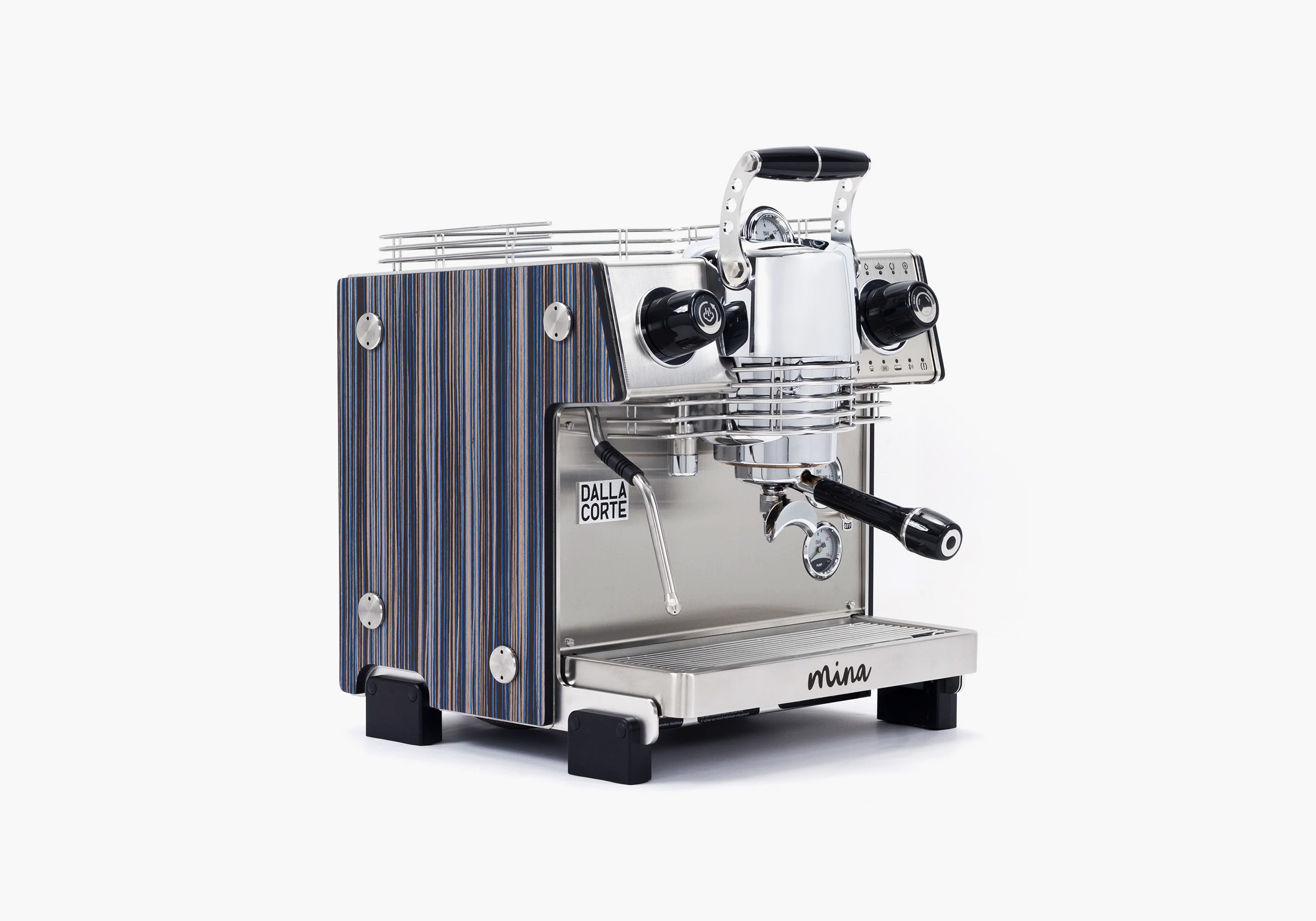

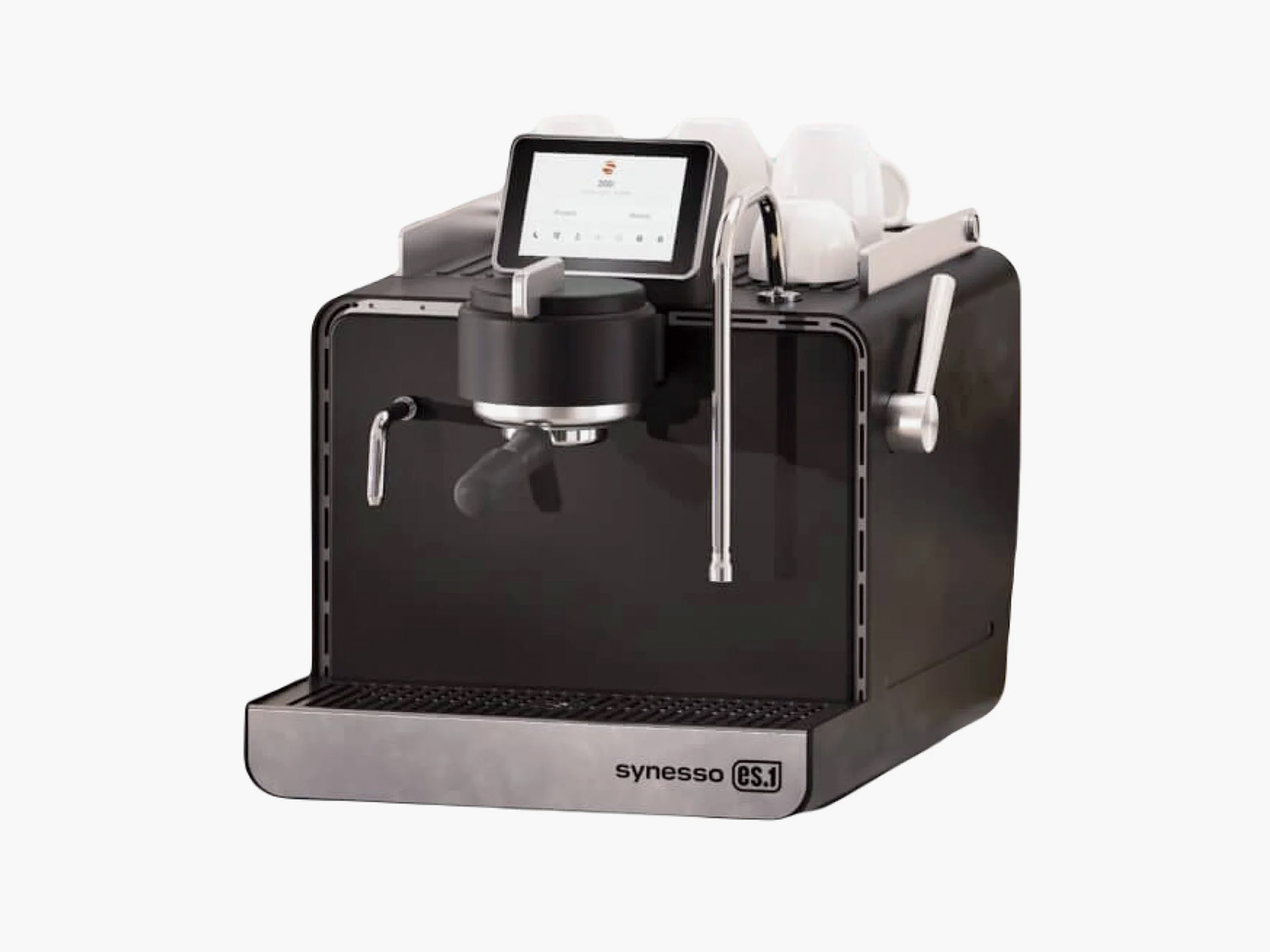
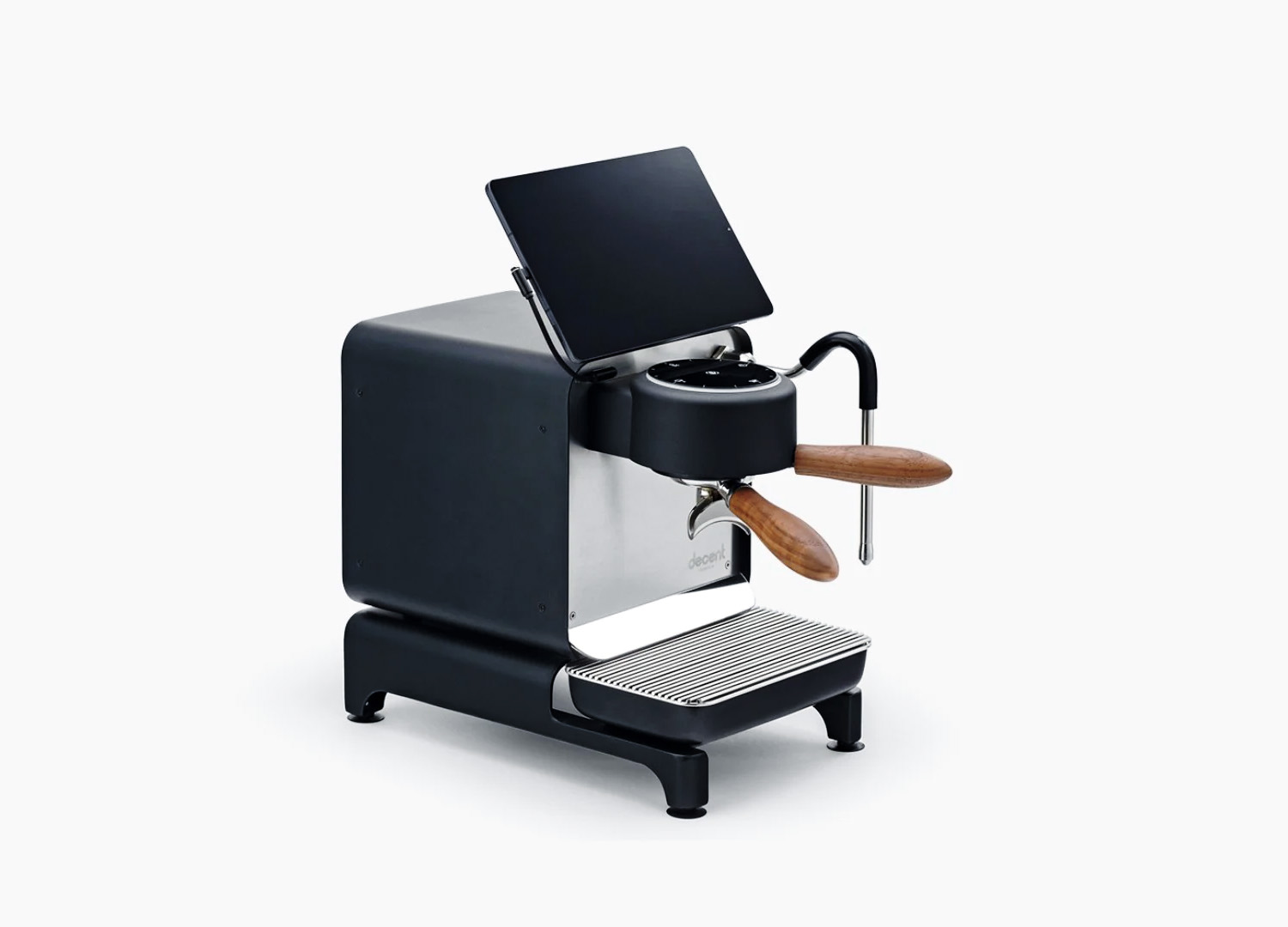
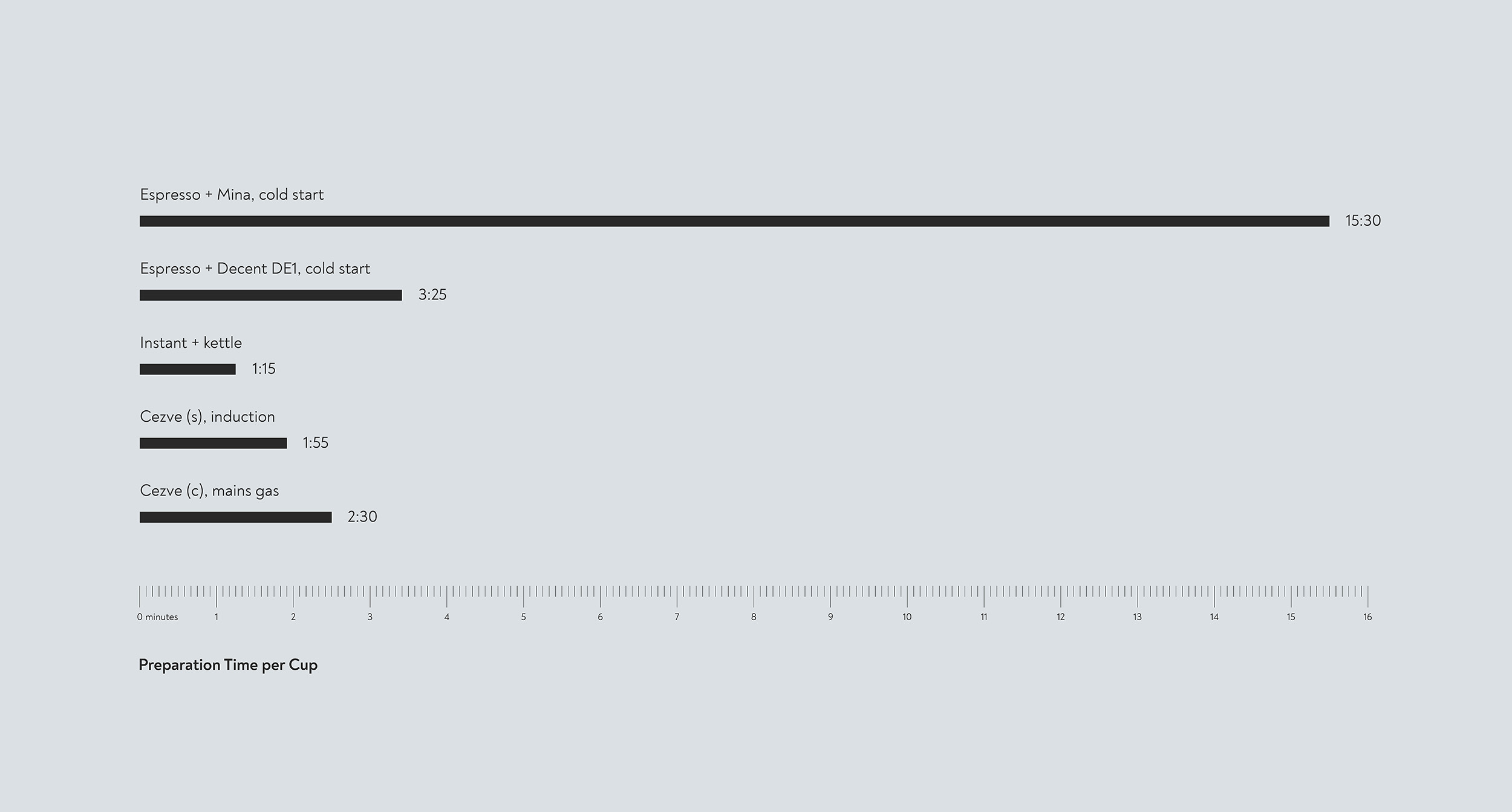
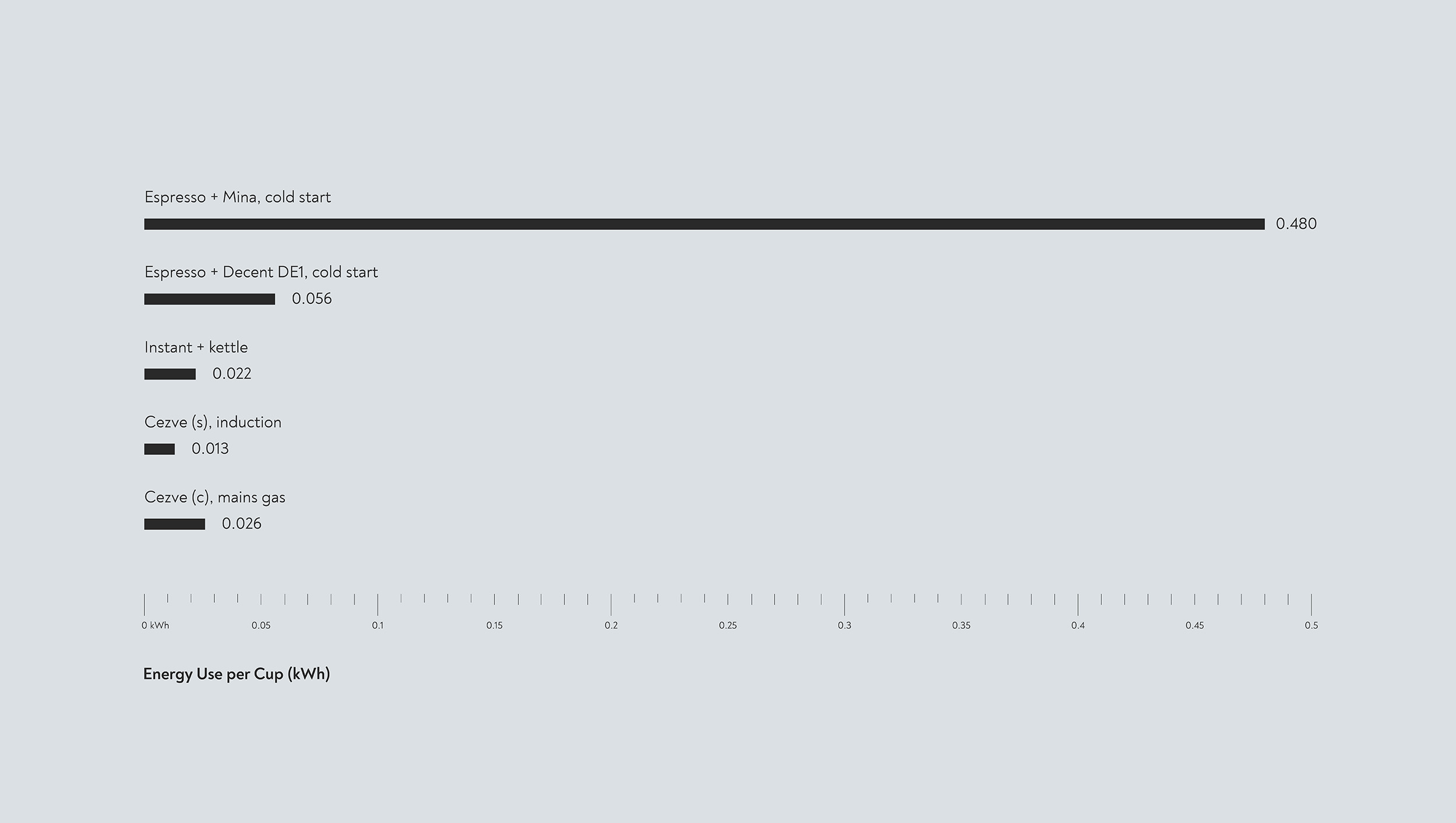
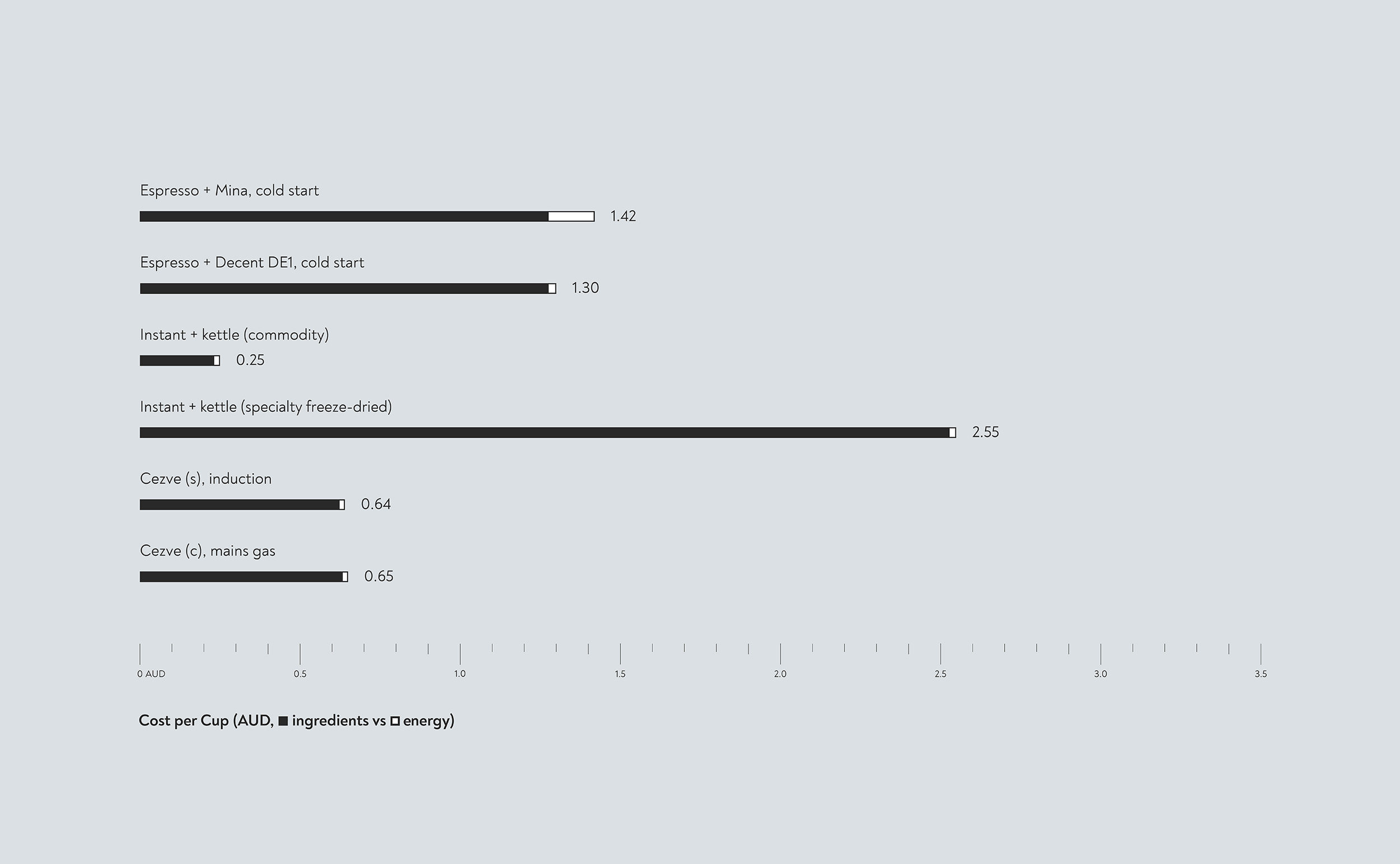

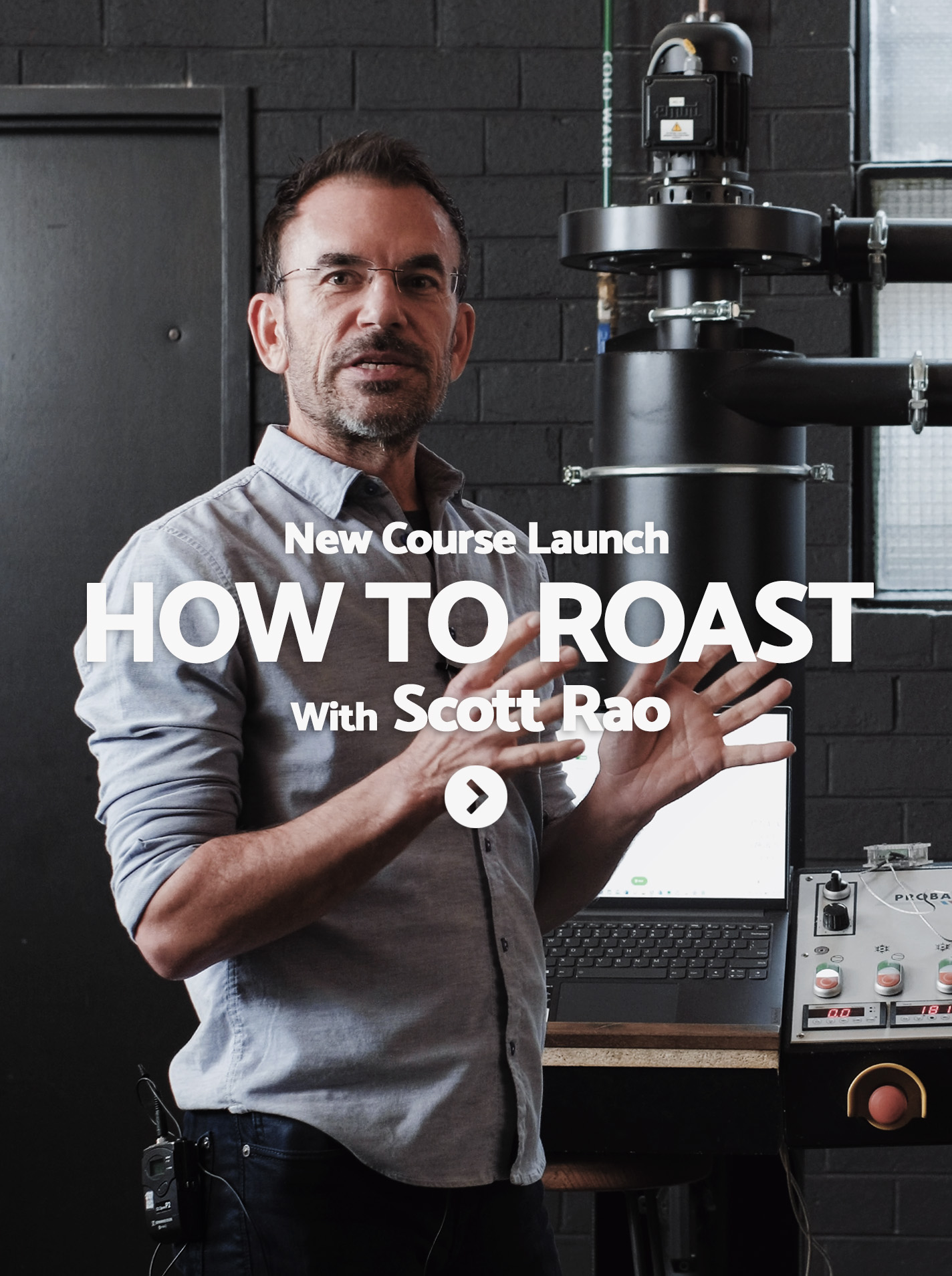
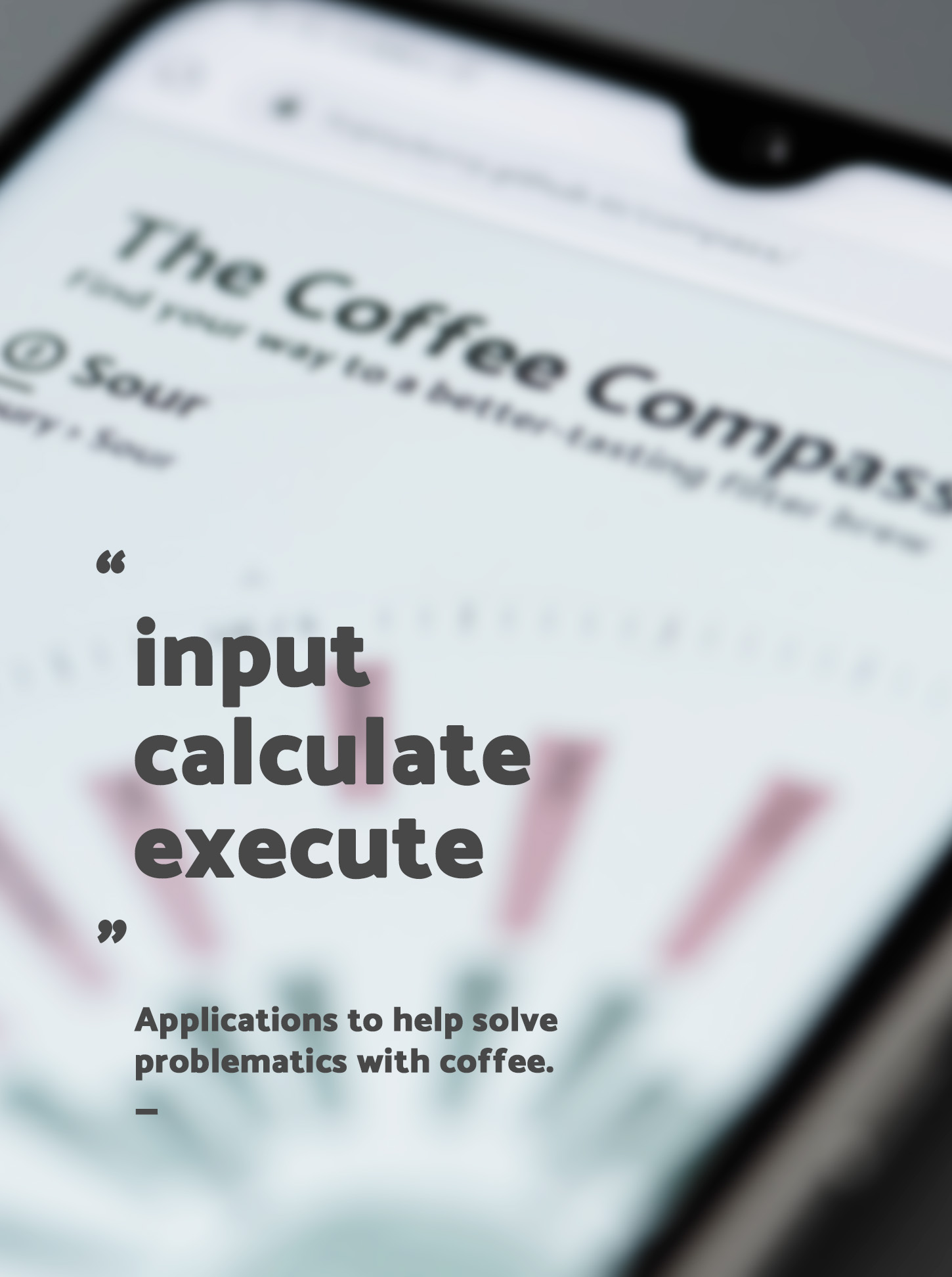
0 Comments